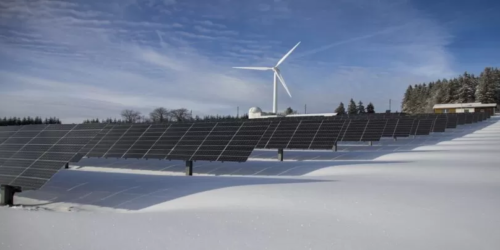Green energy provides a solution for cheaper power generation and the government now switches to a 50% hybrid system. With new advancements in renewable technologies, Pakistan is also focusing on producing low-cost electricity through renewable energy like solar and wind.
Green energy solutions may help Pakistan overcome higher electricity rates that have become unaffordable for the consumers. The government has already set the target to increase the share of solar and wind through hybrid systems to cut the prices of energy.
Solar and wind are major sources of green energy. However, the government is preferring hybrid renewable systems to produce cheaper power generation. In a bid to execute a plan, the government has decided now to prefer renewable energy generation through 50 percent hybrid systems through on-grid projects in line with the principle of low cost from the year 2023-24 onwards under the Indicative Generation Capacity Expansion Plan (IGCEP).
Engr. Faiz Bhutta Sr. Energy Consultant told Newztodays.com that Hybrid power system is the multiple sources of electricity system which can be solar wind hybrid, grid solar hybrid, diesel solar hybrid, grid, diesel, solar hybrid, solar biomass or any hybrid type and if it is standalone system then it is called Microgrid system. The future of power is hybrid power optimization and management.
Hybrid system optimization is done through an IOT based monitoring, control and management system. This is not only monitoring and measuring but controls which power source is economical in a real-time situation, he further said.
The government has decided that targets for new renewable energy projects will be governed based on the least cost principle as per ARE Policy 2019 to promote green energy. AEDB is currently implementing the policy to execute renewable energy projects.
Due to capacity factor advantage, project additions shall be through utilizing hybrid RE resources in power generation as 50% cost factor for hybrid vs 33% and 19% for wind and solar alone respectively.
The current IGCEP iteration for RE projects will be done under existing targets as per ARE Policy 2019, subject to the least-cost principle.
RE on-grid power projects in balance target block share as stipulated in the ARE Policy 2019 i.e.,20% by the year 2025 and 30% by the year 2030 (including net-metering), candidate block will be considered on respective wind/solar/hybrid technologies from the year 2023-24 onwards on least-cost principle.
Energy sector companies in Pakistan are producing electricity through different renewable energy resources mainly wind, solar and Baggassse. However, there are advantages and disadvantages of renewable energy generation through alternate ways of generating power.
Pakistan has been mainly dependent on oil to generate thermal power. Therefore, electricity is expensive due to the poor mix of renewable energy in the basket. With time, the problems in the energy sector continue to plague the entire chain. Different governments have made efforts to address the woes in the power sector. But, they have not been able to remove the constraints.
At present, there are three types of renewable energy in Pakistan which include wind, solar, and bagasse. However, the share of alternate fuels in the energy mix is poor. Pakistan currently produces around 4 percent from the renewable energy sector.
According to power statics for March 2021, the share of wind is 1.89%, solar 0.74%, and Baggasse 1% in total electricity generation. The share of hydel stands at 19.4%, coal 30.5%, RFO 2.6%, gas 11.5%, RLNG 21.11%, and nuclear 10.49%.
In the year 2015, the share of coal was very low. However, Pakistan and China initiated several power projects including coal that led to increasing its share.
This is the same case in RLNG which consumption has increased in the power sector. This is considered to be advanced biofuel over renewable energy. Like other alternate resources, this is also clean energy fuel that reduces carbon emissions and boosts green energy.
Its share in the power sector is over 21 %. Its usage in a different country is around 6 % as an alternative. However, the share of this fuel has increased. With the upcoming new LNG terminal, its share will go up further.





